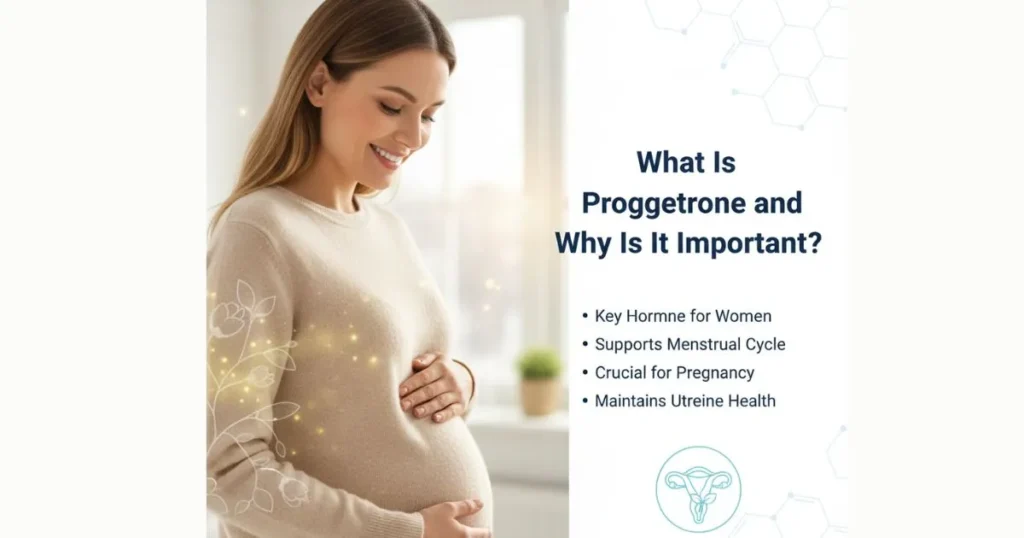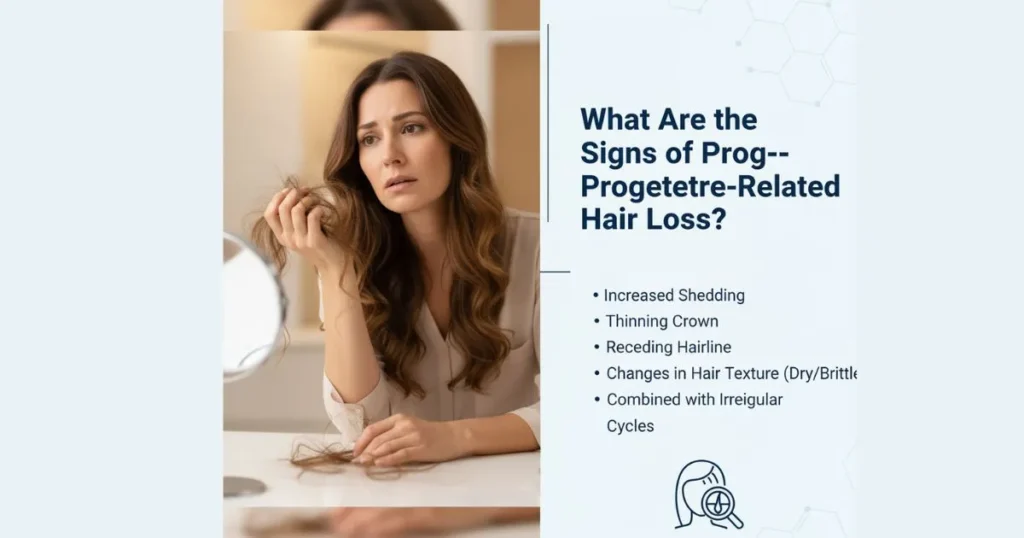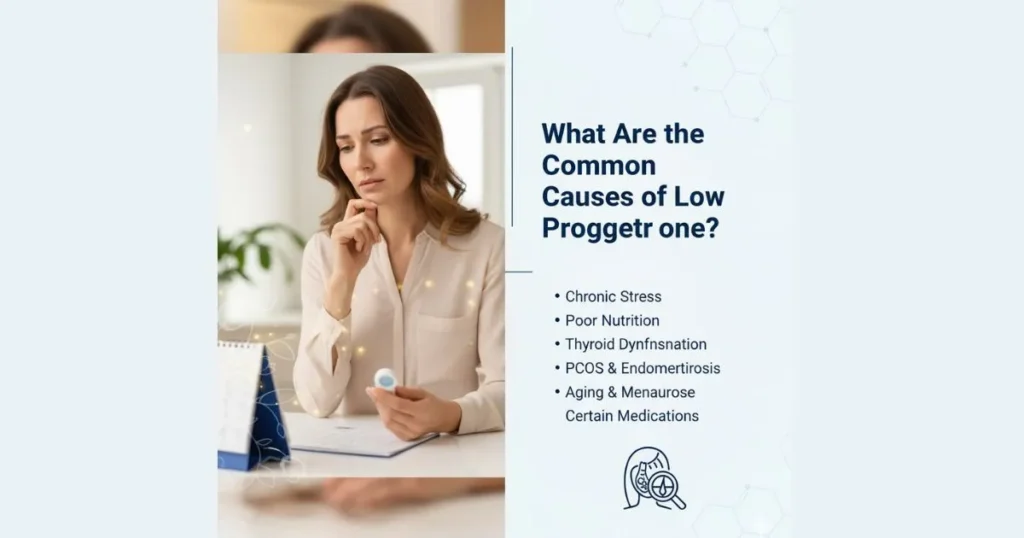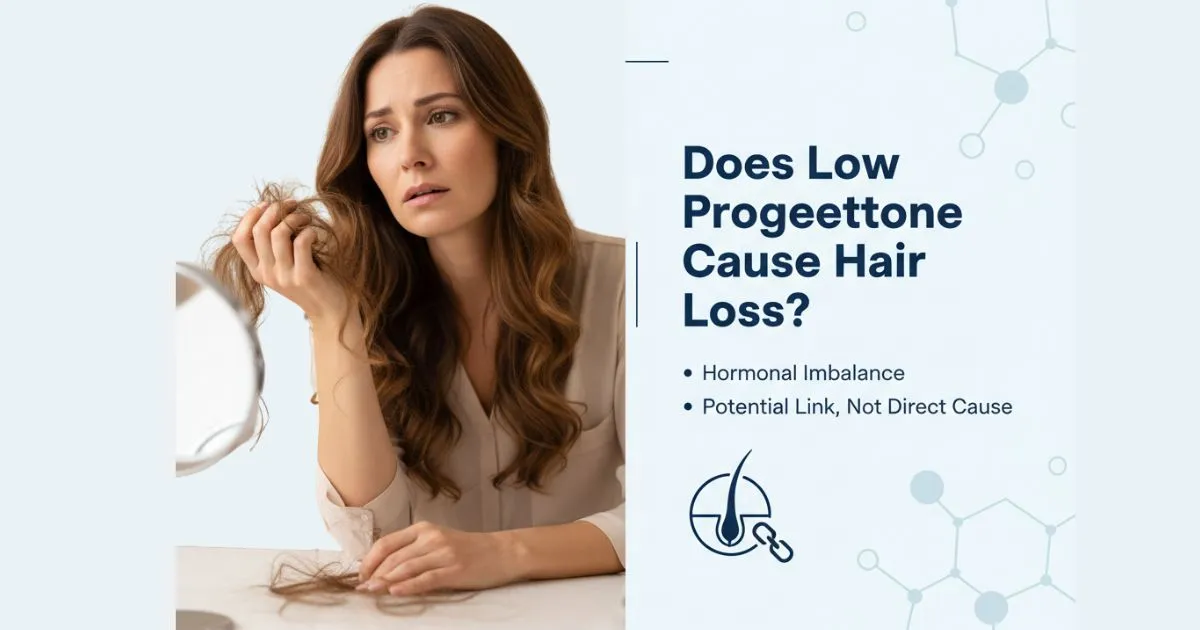Noticing extra hair in your brush can be alarming, quickly leading to concerns about what’s causing it. While stress and diet are important factors, hormones—especially progesterone—often play a larger role in hair health than we realize.
You may wonder, “How does a hormone impact my hair?” The answer: a lot. Hormones act as messengers controlling hair growth. Once they fall out of balance, hair health can suffer. Here, we’ll focus on the impact of low progesterone—a possibly overlooked driver of hair thinning—so you can better understand the hormonal connection and your hair.
What Is Progesterone and Why Is It Important?

Think of progesterone as a superhero hormone that does way more than you might realize. Most people know it’s important for pregnancy and regulating menstrual cycles, but its job description is much bigger than that. Progesterone is a natural peacekeeper in your body. It helps balance out other hormones, like estrogen, keeping everything running smoothly.
Beyond its role in reproduction, progesterone plays a crucial role in your overall well-being. It can help you sleep better, maintain a stable mood, and even promote healthy skin. It has a calming effect on the brain, which is why you might feel more anxious or irritable when its levels are low. So, when progesterone takes a nosedive, it’s not just your reproductive health that feels it—your hair, skin, and emotional state do, too.
How Does Low Progesterone Affect Hair Health?
So, how does a drop in this calming hormone lead to hair loss? Dihydrotestosterone (DHT), which is a powerful hormone derived from testosterone, can negatively affect your hair follicles—the little sacs in your scalp where hair grows.
Progesterone acts as a natural shield to block DHT from affecting your hair follicles. Healthy progesterone levels mean DHT can’t do as much damage, but if progesterone drops, DHT can shrink follicles and make them produce thinner strands or stop growing hair altogether.
This creates a hormonal imbalance, where other hormones, such as androgens (male hormones, including testosterone), become more dominant. This imbalance doesn’t just cause hair thinning; it can also lead to other issues, such as acne and unwanted facial hair. It’s a cascading effect that all starts with that initial dip in progesterone.
Read More: Understanding Trichodynia: Causes, Symptoms & Treatment Options
What Are the Signs of Progesterone-Related Hair Loss?

Hormonal hair loss often looks different from other types of hair loss. Instead of seeing distinct bald patches, you might notice a more general, widespread thinning. This is known as diffuse thinning. You might first notice a wider part in your hair or realize that your ponytail feels less full than it used to. The hair loss is usually concentrated on the top and crown of your head.
However, hair loss is rarely the only symptom of low progesterone levels. Since this hormone is involved in so many bodily functions, you’ll likely notice other signs that something is off. Pay attention to your body. Are you also experiencing:
- Irregular periods or spotting between cycles?
- Mood swings, anxiety, or feeling more irritable than usual?
- Trouble falling asleep or staying asleep?
- Do you experience headaches or migraines, particularly around the time of your menstrual cycle?
- Weight gain, particularly around your middle?
If you’re nodding along to a few of these, it could be a strong clue that a hormonal imbalance is at play. Recognizing these interconnected symptoms is the first step toward identifying the root cause. This is why looking at the bigger picture is so important when dealing with potential low progesterone hair loss.
Can Low Progesterone Cause Hair Loss in Men?
This is a fantastic question and one that isn’t discussed nearly enough. While hair loss in men is most famously linked to DHT (androgenetic alopecia), progesterone still plays a small but important role in their hormonal ecosystem. Men also produce progesterone, just in much smaller amounts than women. It’s made in their adrenal glands and testes.
Just as in women, progesterone in men helps to counteract the effects of other hormones. It can help balance estrogen levels and, you guessed it, block some of the effects of DHT. When a man’s progesterone levels are unusually low, it could theoretically contribute to an environment where DHT has more influence, potentially speeding up hair loss. While it’s not the primary cause of baldness in men, it’s a piece of the hormonal puzzle that highlights how interconnected everything is.
The Science Behind Progesterone and Hair Follicles
Let’s zoom in on what’s happening right at the scalp level. Your hair grows in a cycle with three main phases:
- Anagen (The Growing Phase): This is the stage during which your hair is actively growing. It can last for 2 to 7 years.
- Catagen (The Transition Phase): A short phase where the hair follicle shrinks.
- Telogen (The Resting Phase): The follicle remains dormant for approximately 3 months before the hair sheds, and a new one begins to grow.
Hormones are the directors of this entire show. Progesterone helps to keep your hair in the anagen (growing) phase for longer. It acts as a natural DHT blocker, protecting the follicles from the shrinking effect of this powerful androgen. When progesterone levels are healthy, more of your hair is in the growth phase, leading to a fuller, thicker head of hair.
When progesterone levels drop, the balance is disrupted. DHT can more easily bind to the follicles, causing them to prematurely enter the resting phase and shorten the growth phase. This leads to increased shedding and the growth of finer, weaker hair. It’s a clear example of how hormonal balance is essential for a healthy hair growth cycle.
What Are the Common Causes of Low Progesterone?

So, what makes this important hormone disappear? There are several reasons, and they can be grouped into three main categories.
- Natural Causes: As we age, our hormone levels naturally change. Perimenopause and menopause are the most common times for women to experience a significant drop in progesterone. After childbirth, the sudden drop in pregnancy hormones can also trigger temporary hair loss, a condition known as postpartum telogen effluvium.
- Medical Causes: Certain health conditions can disrupt your hormonal balance. Polycystic Ovary Syndrome (PCOS) is a common one, often characterized by low progesterone and high androgens. Thyroid disorders, whether an overactive or underactive thyroid, can also interfere with progesterone production. Another potential cause is adrenal fatigue, where chronic stress wears out your adrenal glands, which are responsible for producing some of your progesterone.
- Lifestyle Factors: Your daily habits have a huge impact on your hormonal health. Chronic stress is a major enemy of progesterone. When you’re stressed, your body pumps out the stress hormone cortisol. Since cortisol and progesterone are derived from the same precursor molecule, your body will prioritize producing cortisol, thereby “stealing” the building blocks from progesterone. A poor diet, lack of exercise, and insufficient sleep can also contribute to hormonal imbalances and low progesterone levels, which can lead to hair loss.
How to Diagnose Progesterone Deficiency?
If you suspect you have low progesterone, it’s important not to self-diagnose. The best first step is to consult a healthcare provider, such as a doctor or an endocrinologist. They can order a hormonal panel, which is a simple blood test to check your levels of progesterone and other key hormones, such as estrogen, testosterone, and thyroid hormones. For women who are still menstruating, the timing of the test is crucial, as progesterone levels fluctuate throughout the cycle. Your doctor will likely want you to get tested about a week after ovulation.
What about at-home testing kits? These are becoming more popular and can offer some initial insights. They typically use saliva or a finger-prick blood sample. While they can be a convenient starting point, they may not be as accurate as a lab test ordered by a doctor. It’s always best to discuss any results from an at-home kit with a healthcare professional to get a full and accurate diagnosis.
Treatment Options for Progesterone-Related Hair Loss
Once low progesterone levels are confirmed, several options are available to address them. Treatment often involves a mix of medical and natural approaches.
- Medical Treatments: Your doctor might suggest hormone replacement therapy (HRT), which can come in the form of pills, creams, or patches. Bioidentical progesterone is a popular choice because it’s chemically identical to the hormone your body naturally produces. It’s important to discuss the risks and benefits of any HRT with your doctor.
- Topical vs. Oral Progesterone: For hair loss, some experts believe topical progesterone creams applied to the skin might be more effective because they can be absorbed directly into the bloodstream without being broken down by the liver first. However, oral progesterone is also widely used. The best option depends on your individual health needs and your doctor’s recommendation.
- Natural Remedies: You can also support your hormone levels through lifestyle changes. A diet rich in nutrients such as zinc, magnesium, and vitamin B6 can be beneficial. Managing stress through techniques such as yoga, meditation, or simply taking a walk in nature can make a significant difference. Supplements may also be beneficial, but it’s essential to consult your doctor before starting any new regimen.
Read More: How Big Is the Average Forehead
Beyond Progesterone: Other Hormones That Impact Hair Health
Progesterone doesn’t work in a vacuum. Hair health is a team sport, and several other hormones are involved.
- Estrogen, like progesterone, helps maintain hair in the growth phase. Low estrogen, common during menopause, can also contribute to hair thinning.
- Testosterone: While it’s the source of hair-damaging DHT, a healthy balance of testosterone is needed for overall health.
- Thyroid Hormones: An imbalance in thyroid hormones can cause widespread hair shedding.
- Cortisol, the stress hormone, can disrupt the hair cycle and deplete progesterone levels.
The key is harmony. When one hormone is out of balance, it often creates a ripple effect that impacts all the others. A holistic approach that considers all these hormonal players is the most effective way to address low progesterone hair loss.
Can Progesterone Reverse Hair Loss?
This is the big question everyone wants answered. The good news is that in many cases, yes, hair loss caused by a hormonal imbalance can be improved or even reversed. When you restore your progesterone levels, you give your hair follicles a fighting chance to recover. The protective shield against DHT is back in place, allowing the hair growth cycle to return to normal.
However, patience is essential. Hair grows slowly—about half an inch per month. It can take anywhere from 3 to 6 months to notice a decrease in shedding and see the first signs of new growth. It may take a year or more to see a significant difference in thickness. The key is to be consistent with your treatment and lifestyle changes. Remember, it took time for the imbalance to cause hair loss, and it will take time to reverse it.
Preventing Hormonal Hair Loss: Tips for Long-Term Hair Health
The best defense is a good offense. Maintaining hormonal balance is key to preventing future hair loss.
- Balance Your Diet: Eat a diet rich in whole foods, including lean proteins, healthy fats, and a variety of fruits and vegetables. Foods rich in zinc (such as nuts and beans), magnesium (found in leafy greens and dark chocolate), and vitamin B6 (found in tuna, salmon, and chickpeas) can support progesterone production.
- Manage Stress: Find what works for you—whether it’s mindfulness, deep breathing, or a creative hobby. Reducing chronic stress is one of the most powerful things you can do for your hormones.
- Prioritize Sleep: Aim for 7-9 hours of quality sleep per night. Your body repairs itself and regulates hormones while you sleep.
- Exercise Smart: Regular, moderate exercise is beneficial for hormone balance. Just be careful not to overdo it, as excessive exercise can be a form of stress on the body.
FAQs
Can low progesterone cause facial hair growth?
Indirectly, yes. Low progesterone can lead to an imbalance called estrogen dominance, which can, in turn, increase androgens, leading to unwanted hair on the face.
How long does it take to balance progesterone levels?
It varies for everyone. With consistent lifestyle changes and/or medical treatment, some people notice improvements within a few months, while for others, it may take longer.
Is postpartum hair loss related to low progesterone?
Absolutely. During pregnancy, progesterone and estrogen levels are very high, which keeps your hair in the growth phase. After you give birth, these hormones plummet, causing a large number of hairs to enter the shedding phase at once. This is why many new mothers experience significant but temporary hair loss a few months after giving birth.
Conclusion
Navigating the world of hair loss can feel overwhelming and emotional, but understanding the root cause is the most empowering step you can take. The connection between our hormones and our hair is undeniable, and for many, uncovering and addressing low progesterone hair loss is the key to restoring not just their hair, but their overall sense of well-being.
Your hair is often a reflection of your internal health. If you’re struggling with thinning hair, listen to what your body might be telling you. Consult a trusted healthcare provider, undergo the necessary tests, and develop a personalized plan. With the right knowledge and support, you can work towards rebalancing your hormones and reclaiming the healthy, vibrant hair you deserve.
